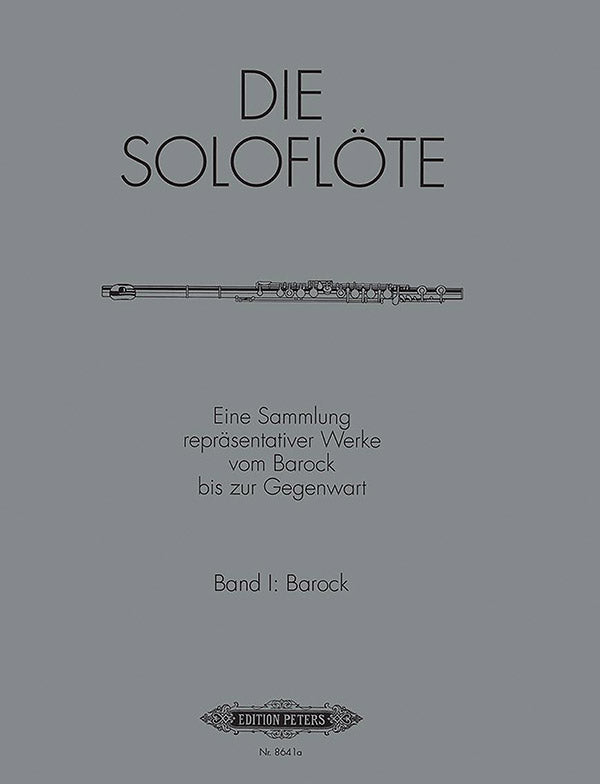The Solo Flute - Volume 1 (The Baroque Era)
In stock and typically ships within 1 business day.
- Composers: Carl Philipp Emanuel Bach (1714-1788), Charles De Lusse (1720-1774), Johann Sebastian Bach (1685-1750), Jacques-Martin Hotteterre (1674-1763), Georg Philipp Telemann (1681-1767), Michel Blavet (1700-1768), Johann Joachim Quantz (1697-1773), Marin Marais (1656-1728), Joseph Bodin de Boismortier (1689-1755), Jean-Daniel Braun (1703-1738), Antoine Mahaut (1719-1785), Sebastian Bodinus (1700-1759)
- Editor: Mirjam Nastasi
- Instrumentation (this edition): Flute
- Originally for: Basso continuo, Flute, Flute I, Flute II
- ISMN:
- Size: 9.1 x 12.0 inches
Description
Solo Flute (no accompaniment)
- Marin Marais: Les Folies d'Espangne
- Jacques Hotteterre: Echo's, Prelude dm, Prelude bm, Prelude em, Prelude CM, Prelude CM, Prelude em, Prelude DM, Prelude GM, Prelude am, Prelude FM
- Joseph Bodin de Boismortier: Suite fm, Op. 35, No. 5, Suite am, Op. 35, No. 6
- Michel Blavet: Gigue en Rondeau
- Jean Daniel Braun: Suite em, Suite bm, Suite em
- Antoine Mahaut: Allegro GM
- Telemann: Fantasia DM, Fantasia em, Fantasia F-sharp m, Fantasia dm
- Johann Sebastian Bach: Partita am BWV 1013
- Sebastian Bodinus: Capricia en Gigue
- Johann Joachim Quantz: Alla francese, Capriccio BM, Preludio DM, Capriccio GM, Fantasia em, Fantasia CM
- Carl Philipp Emanuel Bach: Sonata am Wq. 132
- Charles Delusse: Caprice AM, Caprice AM
Works:
- Marais: Les Folies d'Espagne
- Hotteterre: Echoes, Op. 2, No. 8
- Hotteterre: 10 Préludes from L'art de Préluder, Op. 7
- Boismortier: Suite in B Minor, Op. 35, No. 5
- Boismortier: Suite in A Major, Op. 35, No. 6
- Blavet: Gigue en Rondeau & Rondeau from Premier recueil de pieces
- Braun: 3 Suites (E Minor [1], B Minor, E Minor [2]) from Sonata de Mr. Braun (1740)
- Mahaut: Allegro in G Major from Nouvelle Méthode pour jouer la Flûte Traversière (1759)
- Nos 7, 8, 9, 11 from Telemann: 12 Fantasias for Solo Flute, TWV 40:2-13
- Bach: Partita in A Minor, BWV 1013
- Bodinus: Caprice & Gigue
- Alla francese from Quantz: Caprices, Fantasies and Pieces, QV 3:1
- Capriccio in B-Flat Major from Quantz: Caprices, Fantasies and Pieces, QV 3:1
- Prelude in D Major from Quantz: Caprices, Fantasies and Pieces, QV 3:1
- Capriccio in G Major from Quantz: Caprices, Fantasies and Pieces, QV 3:1
- Fantasia in E Minor from Quantz: Caprices, Fantasies and Pieces, QV 3:1
- Fantasia in C Major from Quantz: Caprices, Fantasies and Pieces, QV 3:1
- C.P.E. Bach: Flute Sonata in A Minor, Wq. 132
- De Lusse: Caprice in A Major, No. 4 from 12 Caprices (From L'art De La Flute Traversiere) (1760)
Publishers use a lot of words to describe what they sell, and we know it can be confusing. We've tried to be as clear as possible to make sure you get exactly what you are looking for. Below are descriptions of the terms that we use to describe the various formats that music often comes in.
Choral Score
A score for vocalists that only contains the vocal lines. The instrumental parts are not there for reference. Generally, cheaper than a vocal score and requires multiple copies for purchase.
Facsimile
Reproductions of the original hand-written scores from the composer.
Full Score
For ensemble music, this indicates that the edition contains all parts on a single system (there are not separate parts for each player). In larger ensembles, this is for the conductor.
Hardcover
Hardbound. Generally either linen-covered or half-leather.
Orchestral Parts
Similar to a wind set, this is a collection of parts. In the case of strings, the numbers listed are the number of copies included, though generally these are available individually (often with minimum quantities required).
Paperback
When publishers offer multiple bindings (e.g. hardcover) or study scores, this is the "standard" version. If you're planning to play the music, this is probably what you want.
Performance / Playing Score
A score of the music containing all parts on one system, intended for players to share. There are not separate parts for each player.
Set of Parts
For ensemble music, this indicates that there are separate individual parts for each player.
Solo Part with Piano Reduction
For solo pieces with orchestra, this is a version that contains a piano reduction of the orchestra parts. For piano pieces, two copies are typically needed for performance.
Study Score
A small (think choral size) copy of the complete score meant for studying, and not playing. They make great add-ons when learning concertos and small chamber works.
Vocal Score
A score prepared for vocalists that includes the piano/organ part or a reduction of the instrumental parts.
Wind Set
For orchestral music, this is a collection of wind and percussion parts. The specific quantities of each instrument are notated.
With Audio
In addition to the printed music, the edition contains recordings of the pieces. This may be an included CD, or access to files on the internet.
With / Without Fingering (Markings)
Some publishers prepare two copies - a pure Urtext edition that includes no fingering (or bowing) suggestions and a lightly edited version that includes a minimal number of editorial markings.


